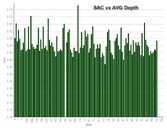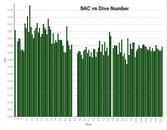Piscean
Registered
And I see no correlation between depth and air consumption. I notice a clear correlation between exertion and SAC and between how cold I was and SAC but not between the depth and SAC. I also see that my SAC decreases the more diving I have done. Mostly I dive in clear blue water with 100ft plus vis, but sometimes I dive in Lake Champlain, VT and I used to dive in Dutch Springs, PA. In total I have 277 dives and I have plotted my SAC for about 220 of those. My SAC lies almost always between 0.3 cu. ft. per minute and 0.6 cu. ft. per minute. What I notice is a wider spread in SAC from 0.3 to 0.6 at around forty feet average depth but that is simply because more of my dives have an average depth of ~40ft than have an average of 80ft or 20ft. In particular, 25 dives were in Bonaire where my SAC never exceeded 0.4cu. ft. per minute because it's just so amazingly relaxing and warm (I use a 7mm suit) there.
So Mikeraullt hope that helps. If you want to see my data I'll send it to you. Just PM me.
Piscean.
So Mikeraullt hope that helps. If you want to see my data I'll send it to you. Just PM me.
Piscean.






